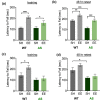Sex-dependent influence of postweaning environmental enrichment in Angelman syndrome model mice
- PMID: 34985196
- PMCID: PMC8865162
- DOI: 10.1002/brb3.2468
Sex-dependent influence of postweaning environmental enrichment in Angelman syndrome model mice
Abstract
Introduction: Angelman syndrome (AS) is a rare neurodevelopmental disorder caused by mutation or loss of UBE3A and marked by intellectual disability, ataxia, autism-like symptoms, and other atypical behaviors. One route to treatment may lie in the role that environment plays early in postnatal life. Environmental enrichment (EE) is one manipulation that has shown therapeutic potential in preclinical models of many brain disorders, including neurodevelopmental disorders. Here, we examined whether postweaning EE can rescue behavioral phenotypes in Ube3a maternal deletion mice (AS mice), and whether any improvements are sex-dependent.
Methods: Male and female mice (C57BL/6J Ube3atm1Alb mice and wild-type (WT) littermates; ≥10 mice/group) were randomly assigned to standard housing (SH) or EE at weaning. EE had a larger footprint, a running wheel, and a variety of toys that promoted foraging, burrowing, and climbing. Following 6 weeks of EE, animals were submitted to a battery of tests that reliably elicit behavioral deficits in AS mice, including rotarod, open field, marble burying, and forced swim; weights were also monitored.
Results: In male AS-EE mice, we found complete restoration of motor coordination, marble burying, and forced swim behavior to the level of WT-SH mice. We also observed a complete normalization of exploratory distance traveled in the open field, but we found no rescue of vertical behavior or center time. AS-EE mice also had weights comparable to WT-SH mice. Intriguingly, in the female AS-EE mice, we found a failure of EE to rescue the same behavioral deficits relative to female WT-SH mice.
Conclusions: Environmental enrichment is an effective route to correcting the most penetrant phenotypes in male AS mice but not female AS mice. This finding has important implications for the translatability of early behavioral intervention for AS patients, most importantly the potential dependency of treatment response on sex.
Keywords: behavior therapy; mouse; neurodevelopmental disorders; sex differences; transgenic.
© 2021 The Authors. Brain and Behavior published by Wiley Periodicals LLC.
Figures






Similar articles
-
A behavioral test battery for mouse models of Angelman syndrome: a powerful tool for testing drugs and novel Ube3a mutants.Mol Autism. 2018 Sep 14;9:47. doi: 10.1186/s13229-018-0231-7. eCollection 2018. Mol Autism. 2018. PMID: 30220990 Free PMC article.
-
Behavioral deficits in an Angelman syndrome model: effects of genetic background and age.Behav Brain Res. 2013 Apr 15;243:79-90. doi: 10.1016/j.bbr.2012.12.052. Epub 2013 Jan 4. Behav Brain Res. 2013. PMID: 23295389 Free PMC article.
-
Acute administration of lovastatin had no pronounced effect on motor abilities, motor coordination, gait nor simple cognition in a mouse model of Angelman syndrome.J Neurodev Disord. 2025 May 17;17(1):27. doi: 10.1186/s11689-025-09616-6. J Neurodev Disord. 2025. PMID: 40382580 Free PMC article.
-
Angelman Syndrome: From Mouse Models to Therapy.Neuroscience. 2020 Oct 1;445:172-189. doi: 10.1016/j.neuroscience.2020.02.017. Epub 2020 Feb 21. Neuroscience. 2020. PMID: 32088294 Review.
-
Gene Therapy for Angelman Syndrome: Contemporary Approaches and Future Endeavors.Curr Gene Ther. 2020;19(6):359-366. doi: 10.2174/1566523220666200107151025. Curr Gene Ther. 2020. PMID: 31914913 Review.
Cited by
-
Dissociating motor impairment from five-choice serial reaction time task performance in a mouse model of Angelman syndrome.Front Behav Neurosci. 2022 Sep 23;16:968159. doi: 10.3389/fnbeh.2022.968159. eCollection 2022. Front Behav Neurosci. 2022. PMID: 36212189 Free PMC article.
-
Multidimensional analysis of behavior predicts genotype with high accuracy in a mouse model of Angelman syndrome.Transl Psychiatry. 2022 Oct 3;12(1):426. doi: 10.1038/s41398-022-02206-3. Transl Psychiatry. 2022. PMID: 36192373 Free PMC article.
-
Multisensory Stimulation Reverses Memory Impairment in Adrβ3KO Male Mice.Int J Mol Sci. 2023 Jun 23;24(13):10522. doi: 10.3390/ijms241310522. Int J Mol Sci. 2023. PMID: 37445699 Free PMC article.
-
Deficits in cerebellum-dependent learning and cerebellar morphology in male and female BTBR autism model mice.NeuroSci. 2022 Dec;3(4):624-644. doi: 10.3390/neurosci3040045. Epub 2022 Nov 9. NeuroSci. 2022. PMID: 37366488 Free PMC article.
-
Comparative profiling of white matter development in the human and mouse brain reveals volumetric deficits and delayed myelination in Angelman syndrome.Mol Autism. 2024 Dec 26;15(1):54. doi: 10.1186/s13229-024-00636-y. Mol Autism. 2024. PMID: 39726042 Free PMC article.
References
-
- Adhikari, A. , Copping, N. A. , Beegle, J. , Cameron, D. L. , Deng, P. , O'Geen, H. , Segal, D. J. , Fink, K. D. , Silverman, J. L. , & Anderson, J. S. (2021). Functional rescue in an Angelman syndrome model following treatment with lentivector transduced hematopoietic stem cells. Human Molecular Genetics, 30(12), 1067–1083. 10.1093/hmg/ddab104 - DOI - PMC - PubMed
Publication types
MeSH terms
Substances
Grants and funding
LinkOut - more resources
Full Text Sources
Molecular Biology Databases
Research Materials

